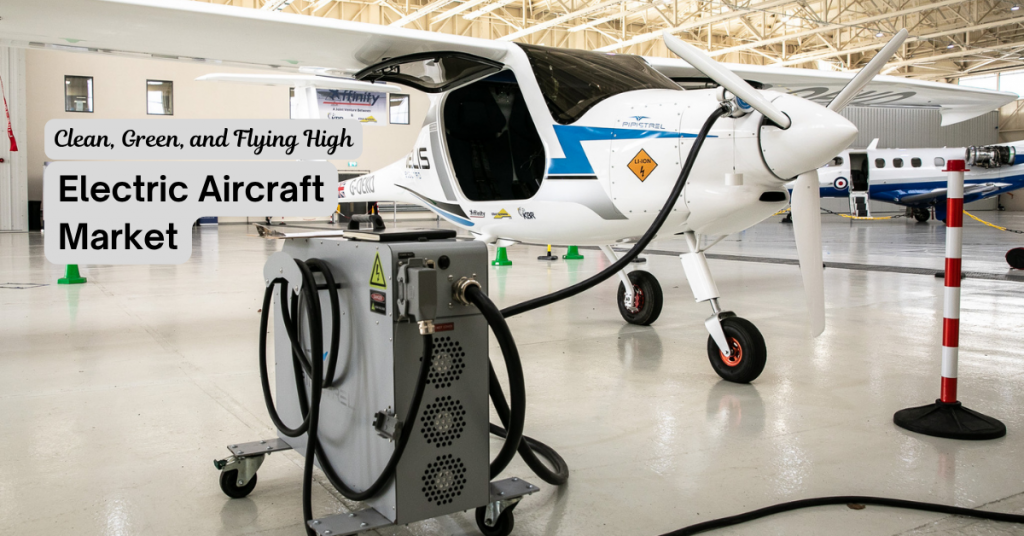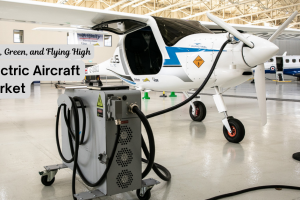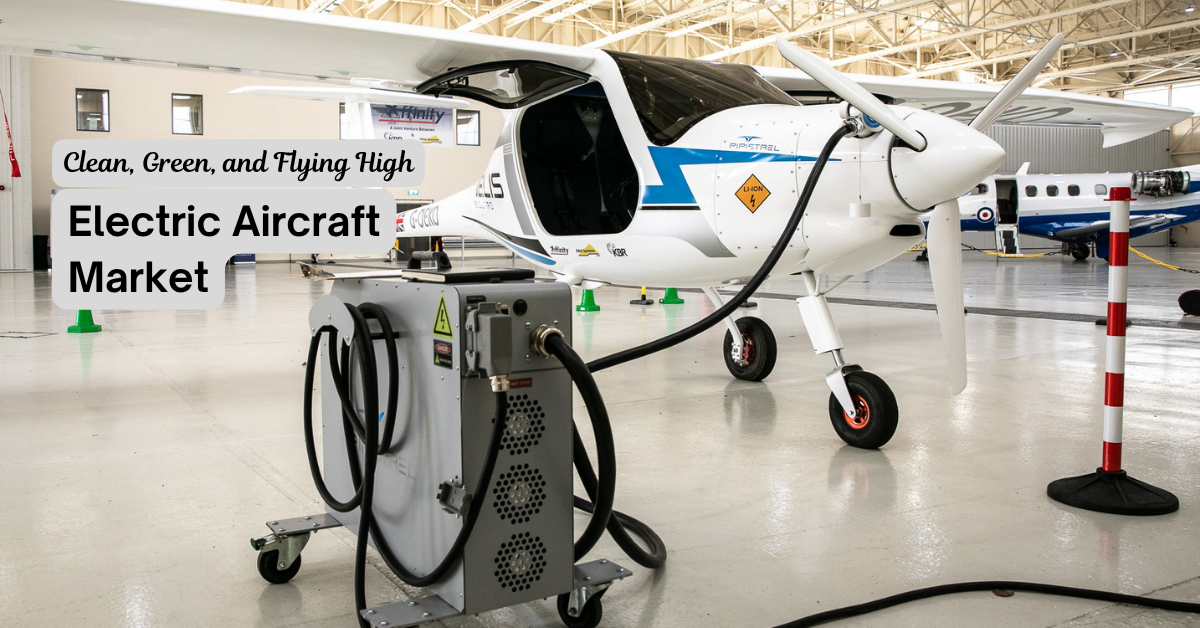
Market Overview
The Electric Aircraft market size was valued at USD 4,827.5 million in 2018, increased to USD 12,320.0 million in 2024, and is anticipated to reach USD 54,403.0 million by 2032, at a CAGR of 20.40% during the forecast period. This rapid growth underscores the increasing demand for sustainable aviation solutions that reduce carbon emissions and dependency on fossil fuels. As global climate mandates tighten and technological advancements in electric propulsion systems gain traction, the electric aircraft sector is becoming a key pillar of the aviation industry’s transition to net-zero emissions.
The relevance of the electric aircraft market in today’s global context cannot be overstated. Governments and private firms alike are investing heavily in electric aviation as a pathway toward sustainable transportation. This includes short-haul flights powered by hybrid or fully electric propulsion, especially within urban air mobility and regional transport sectors. Furthermore, policy-driven support in the form of carbon taxes, subsidies, and green aviation policies is accelerating the commercialization of electric aircraft. These aircraft not only promise environmental benefits but also offer cost reductions over time due to lower fuel and maintenance requirements. The convergence of environmental responsibility, economic viability, and cutting-edge innovation is propelling the electric aircraft market toward a transformational future.
Read more: https://www.credenceresearch.com/report/electric-aircraft-market
Market Drivers
Growing Demand for Sustainable Aviation
Airlines and governments are under pressure to meet climate goals, and electric aircraft offer a viable path toward zero-emission air travel. With aviation contributing nearly 2.5% of global CO₂ emissions, transitioning to electric propulsion can significantly cut emissions, especially for short-haul and regional flights. The shift aligns with international climate commitments such as the Paris Agreement and national net-zero strategies. Additionally, increasing public and investor demand for ESG-compliant business practices further motivates airlines to adopt cleaner technologies. This push for decarbonization is intensifying the need for sustainable alternatives, positioning electric aircraft as essential to the future of aviation.
Technological Advancements in Battery and Propulsion
Advancements in battery energy density and electric propulsion systems have played a pivotal role in shaping this market. Companies are investing in lithium-sulfur and solid-state batteries that offer higher efficiency, longer range, and quicker charging—enabling more practical electric flight solutions. Innovations in lightweight materials and thermal management systems are also contributing to performance improvements. Furthermore, modular propulsion systems are enabling flexible aircraft design and reducing maintenance complexity. These technological milestones are lowering entry barriers for new manufacturers and improving commercial viability, making electric aviation increasingly scalable.
Cost Reduction in Operations
Electric aircraft offer significantly lower fuel and maintenance costs compared to traditional combustion-based aircraft. The fewer moving parts in electric motors reduce wear and tear, translating into lower operational expenses and making them attractive for commercial use. This cost advantage is particularly important for operators of regional and short-haul flights, where margins are thin. Over time, electric propulsion is expected to provide a total cost of ownership (TCO) advantage. Fleet operators will also benefit from predictive maintenance analytics enabled by digital systems, further streamlining operations and increasing profitability.
Government Support and Incentives
Global governments are incentivizing green aviation technologies through subsidies, grants, and research funding. Programs like NASA’s Electric Aircraft Testbed (EAT) and Europe’s Clean Sky initiative highlight how public funding is accelerating development in this segment. In addition to financial support, regulatory frameworks are being adjusted to encourage innovation without compromising safety. Countries are also investing in infrastructure to support electric aviation, including airport charging stations and dedicated air corridors for urban air mobility. This strong public-sector backing is critical to overcoming the early-stage challenges of the electric aircraft ecosystem and ensuring sustained growth.
Market Challenges
Limited Battery Capacity and Flight Range
Despite progress, current battery technology still limits electric aircraft to short distances. This restricts their utility in long-haul aviation, which remains dominated by conventional jet fuel-based aircraft. Existing lithium-ion batteries face energy density constraints, limiting their ability to power larger aircraft. Battery weight is also a critical concern, as it impacts overall payload capacity and flight efficiency. Until revolutionary breakthroughs occur, such as commercially viable solid-state batteries, long-range electric flights will remain technically and economically unfeasible.
Regulatory and Certification Barriers
The aviation industry operates under stringent safety regulations. Certifying new electric aircraft technologies involves rigorous testing, often slowing down time-to-market and increasing development costs for startups and legacy firms alike. Regulatory bodies like the FAA and EASA must develop new frameworks to evaluate electric propulsion systems, which differ significantly from conventional jet engines. The lack of standardized certification processes for electric aircraft further complicates approvals. Delays in certification hinder investor confidence and commercial deployment, creating a bottleneck for innovation.
High Initial Development Costs
Developing electric aircraft requires significant investment in R&D, infrastructure, and testing. For many firms, these upfront costs are a major barrier to commercialization, especially without assured market demand. The need for specialized materials, advanced propulsion systems, and high-capacity batteries increases development complexity. Small and mid-sized enterprises (SMEs) face financing challenges, as capital expenditure for prototyping and certification can be prohibitive. Without sustained public or private funding, promising innovations risk stalling at the pre-commercial stage.
Charging Infrastructure Deficit
Airports currently lack adequate charging infrastructure to support electric aircraft at scale. Developing a universal charging network poses both logistical and financial challenges for public and private stakeholders. Unlike electric vehicles, aircraft require high-voltage, high-speed charging with safety certifications unique to aviation. Smaller airports, particularly in rural or developing regions, may lack the capacity to invest in such infrastructure. Inconsistency in charging standards across countries also complicates interoperability and route planning for international operations.
Market Opportunity
Urban Air Mobility (UAM)
The growth of UAM—air taxis and short-range intra-city flights—presents a promising use case for electric aircraft. These aircraft are quieter, emission-free, and ideal for dense urban environments. As cities become more congested, electric vertical takeoff and landing (eVTOL) aircraft can offer rapid, clean alternatives for personal and shared mobility. Pilot projects in major cities like Los Angeles, Dubai, and Seoul are already testing feasibility. The emergence of smart cities and 5G connectivity is further enabling real-time traffic management and airspace optimization for UAM.
Regional Connectivity in Developing Economies
Electric aircraft can revolutionize regional air connectivity in countries with poor ground transport infrastructure. This unlocks vast markets across Africa, Southeast Asia, and Latin America. Electrification allows for affordable, point-to-point travel in underserved areas, improving access to healthcare, education, and commerce. These regions also stand to benefit from solar-powered charging stations, making the model more sustainable. Governments in these economies are beginning to explore partnerships with electric aviation firms to boost intra-country connectivity.
Commercialization of Hybrid-Electric Aircraft
Hybrid-electric aircraft are seen as a transitional technology and could capture significant market share by offering extended range and reduced emissions, while easing the transition to fully electric solutions. These aircraft combine conventional engines with electric motors, offering redundancy and reliability. Many established players are targeting this segment as it aligns with existing infrastructure and regulatory frameworks. Hybrid models are already being tested for cargo, commuter, and defense applications, which will serve as proof-of-concept for broader adoption.
Integration of AI and Autonomous Flight
Advanced AI systems combined with electric propulsion can enable autonomous flight, further reducing costs and enhancing safety. This adds another layer of innovation to the electric aircraft ecosystem. Autonomous features like auto-taxi, obstacle avoidance, and adaptive route planning are already being integrated into test models. AI-driven diagnostics also enhance maintenance and performance monitoring, reducing human error. As regulatory frameworks evolve, autonomous electric aircraft could open new markets in cargo delivery, surveillance, and remote area connectivity.
Market Segmentation
By Component
- Battery
- Electric Motor
- Others
By Technology
- All-Electric
- Hybrid-Electric
By Type
- Ultralight Aircraft
- Light Jet
By Power Range
- Less than 500 Km
- More than 500 Km
By Region
North America
- U.S.
- Canada
- Mexico
Europe
- UK
- France
- Germany
- Italy
- Spain
- Russia
- Belgium
- Netherlands
- Austria
- Sweden
- Poland
- Denmark
- Switzerland
- Rest of Europe
Asia Pacific
- China
- Japan
- South Korea
- India
- Thailand
- Indonesia
- Vietnam
- Malaysia
- Philippines
- Taiwan
- Rest of Asia Pacific
Latin America
- Brazil
- Argentina
- Peru
- Chile
- Colombia
- Rest of Latin America
Middle East & Africa
- GCC Countries
- South Africa
- Rest of Middle East and Africa
Regional Analysis
United States and Canada
North America leads in electric aircraft innovation due to strong aerospace infrastructure and investments from Boeing and Joby Aviation. The U.S. also benefits from NASA’s active involvement and favorable regulatory policies. Startups are receiving significant venture funding, while partnerships between defense contractors and eVTOL firms are on the rise. Canada’s remote geography and commitment to green energy make it a suitable market for regional electric flights, especially in underserved northern areas.
Europe (UK, Germany, France, etc.)
Europe is a pioneer in sustainable aviation, with Airbus, Lilium, and Vertical Aerospace leading electric aircraft developments. EU-wide green initiatives and funding under the Clean Sky program drive strong adoption. Countries like Germany and France are offering targeted incentives for low-emission transport technologies. Moreover, Europe’s dense urban clusters and high-speed rail connectivity complement electric aviation, making it easier to integrate into intermodal transportation networks.
Asia Pacific (China, India, Japan)
Asia Pacific is emerging as a major hub. China is investing heavily in urban mobility solutions, while India and Japan support regional electric aviation projects for inter-city travel. Cost sensitivity also favors electric propulsion. China’s robust manufacturing ecosystem and government support are fostering rapid prototype development. India is exploring electric aircraft for regional routes under the UDAN scheme, and Japan is piloting electric air taxis for future deployment during major events like the Osaka Expo 2025.
Latin America (Brazil, Argentina)
Latin American nations are exploring electric aircraft for regional travel, particularly in areas with limited ground connectivity. Brazil’s Embraer is a notable player driving innovation locally. The region’s vast geography and insufficient public transport infrastructure present an opportunity for point-to-point electric aviation. Government collaboration with aerospace firms could accelerate deployment in remote areas, especially where environmental preservation is a priority, such as the Amazon basin.
Middle East & Africa
GCC countries are integrating electric aviation as part of smart city and sustainability projects. In Africa, electric aircraft can help overcome geographic barriers and poor road infrastructure in remote regions. The Middle East is leveraging its financial strength to build futuristic cities like NEOM in Saudi Arabia, where electric aviation is integrated into urban planning. In sub-Saharan Africa, pilot projects for medical supply delivery and cargo transport using electric aircraft are gaining traction with NGO and government support.
Top Companies
- Airbus SE
- Boeing
- Joby Aviation
- Eviation Aircraft
- Pipistrel (Textron)
- Embraer
- Vertical Aerospace
- Lilium GmbH
- Ampaire Inc.
- Beta Technologies
Future Outlook
- Electric aircraft will dominate regional air mobility within the next decade.
- Battery energy density improvements will double current flight ranges.
- Air taxis will become a viable transportation mode in major cities.
- Hydrogen-electric hybrid models will gain traction for mid-range travel.
- Integration of AI and autopilot tech will enhance aircraft safety.
- Carbon credits and emission-based pricing will incentivize electric adoption.
- Pilot training programs for e-planes will expand globally.
- More aerospace startups will enter the electric segment with niche offerings.
- Airlines will experiment with all-electric feeder fleets.
- Electric aircraft leasing and MRO ecosystems will emerge as new industries.
Read more: https://www.credenceresearch.com/report/electric-aircraft-market









